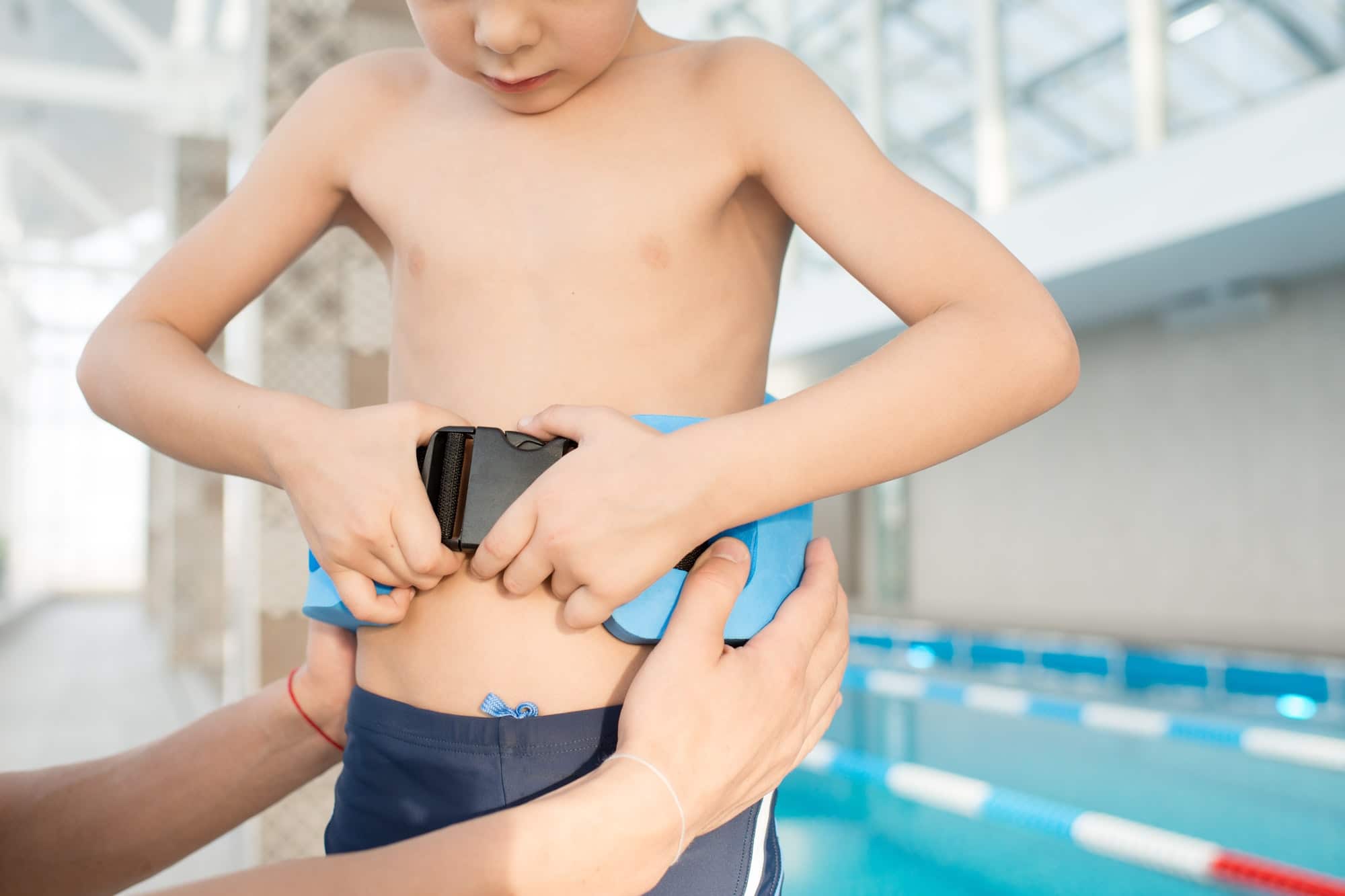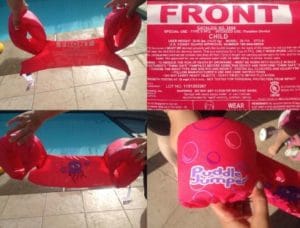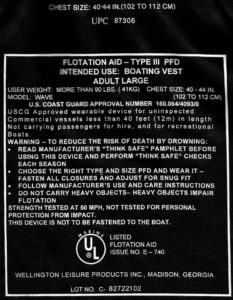Parenting
Choosing the Right Water Flotation Device for Your Child this Summer

As a professional lifeguard, one of the most common questions I get from parents is, “what’s a safe flotation device we can use at the beach or pool this summer?” There is a lot of confusion around this topic and most parents don’t realize that the right or wrong flotation device can mean the difference between life and death. Any person (including children) who cannot swim, is a weak swimmer, or is fearful around water should wear an appropriate flotation device.
Buying a flotation device for your child is a daunting task, you walk into a store and are presented with seemingly infinite choices which can range from blow-up inner tubes with the latest and greatest cartoon character, to water wings, noodles, and life jackets.
A number of parents opt for the ever-popular water wings, which many of us grew up wearing. While these may appear as a good option because of their popularity, they’re really more of a toy than a safety device. Water wings are not an approved flotation device and can easily slip off, restrict the movement of a child’s arms, unexpectedly leak air, and can actually hinder a child’s attempts to swim. Another popular product is bathing suits that have flotation built into them, but like water wings, the floaties can ride up or slide out.
So the question remains, which one do you choose?
The answer comes down to one simple question that parents need to ask: is the flotation device both tested and approved by the United States Coast Guard (USCG)? When I ask parents this I usually get a strange look. “What does that even mean?” When you are looking for a safety flotation device for your child, you need to look for the USCG stamp of approval (see pink image below).
Yes, that usually means I recommend life jackets – and no, they are not just for boating.
Before moving forward, it is important to mention that regardless of the device you choose, it should never be a substitute for constant supervision of your child around any type of water.
When making their selection, parents need to determine the intended purpose of the device; if it is solely for fun and recreation in a controlled environment with constant supervision, then the toy devices mentioned above may be acceptable to use as toys. However, if the purpose is to add an additional layer of safety to ensure that a child remains safer in the water, look for that USCG stamp that assures it is a safety enhancement. When properly selected and used, life jackets will provide a secure tight fit, good buoyant flotation which supports the user, and not greatly reduce arm movement.
When shopping for these types of devices, parents need to be cognizant of a few factors:
USCG -approved devices have a designated weight range assigned to them. Parents should choose one that fits their child’s current weight. This is important to ensure a secure fit and the proper amount of flotation.
There are five types of USCG approved flotation devices. Each type has different advantages and disadvantages which you can read about here. Parents should choose a device based on the planned activity and the design of the device being used. Types 1-3, and some type 5 are vest-style devices and can be suitable for children depending on their weight class, but type four devices are not suitable for weak swimmers or children, as they are designed as throwable devices, like life preserver rings.
Make sure the device being used is in good working order. Ensure that the device is not missing any buckles, discolored, or ripped/torn anywhere.
Parents often ask if life jackets restrict the child’s ability to learn to swim or inhibits a child’s “natural swimming instincts.” The answer to that question depends on what the true purpose of the child being in the water is. A child needs time and proper instruction to learn the coordination skills involved in swimming efficiently. So long as your child is in the water with a qualified swim instructor in a controlled environment they shouldn’t require a life jacket. But let’s say you take the same child to the beach or to grandma and grandpa’s pool just for fun. That environment is less controlled and much can happen in the blink of an eye. For fun around the water, an approved flotation device is the way to go, especially if you want to safeguard for if your child accidentally falls in or suddenly can’t touch the bottom.

The National Drowning Prevention Alliance released a position paper in 2009 on the concept of layers of protection. Do not just rely on one safety step, such as flotation devices or supervision alone, the more safety steps are taken will limit the risk of a tragedy. Other important factors include choosing a safe location to swim, teaching children and adults swimming and water safety, knowing what to do in an emergency, and preventing unapproved access to the water. Every safety step counts for a safer summer of swimming!
Update 7.13.16 | Thanks to TheScientificParent.org reader Ashley who pointed out that puddle jumpers are not approved personal flotation devices for use by children in Canada. Transport Canada advises when parents are choosing a water flotation device for their children they should look at the label to ensure it has been approved by Transport Canada, the Canadian Coast Guard or Fisheries and Oceans Canada.
Resources:
Alga, A. & Collins, M. (2014) Best life jackets for infants, toddlers, and preschoolers. Lucie’s List, Retrieved from http://www.lucieslist.com/lucies-list-blog/2014/06/18/best-life-jackets-for-infants-toddlers-and-preschoolers/
American Red Cross (n.d.) Home pool safety: Maintaining a safe environment around your home swimming pool. Retrieved from: http://www.redcross.org/prepare/disaster/water-safety/home-pool-safety
Balint, V. L. (2014). Do water wings prevent drowning? Raising Arizona Kids. Retrieved from: http://www.raisingarizonakids.com/2014/03/water-wings-floaties-help-prevent-drowning/
Boyse, K. (2010). Water and pool safety. University of Michigan Health System. Retrieved from: http://www.med.umich.edu/yourchild/topics/water.htm
National Drowning Prevention Alliance (2009). Layers of protection around aquatic environments to prevent child drowning. Retrieved from: http://ndpa.org/resources/safety-tips/layers-of-protection/
REI (n.d.). PFDs for kids: How to choose. Retrieved from: http://www.rei.com/learn/expert-advice/kids-personal-flotation-device.html
United States Coast Guard (2014). PFD selection, use, wear, and care. Retrieved from: http://www.uscg.mil/hq/cg5/cg5214/pfdselection.asp#faq
Author
Adam B. Katchmarchi
Adam B. Katchmarchi is a doctoral student at West Virginia University in the Coaching and Teaching Studies Department. His research focuses on drowning prevention education and best practices of managing risk around water. He has worked with hundreds of parents over the years teaching water safety and swimming to children and adults. He is an American Red Cross Instructor Trainer in Swimming and Water Safety Instruction and Lifeguarding Instruction. Adam is currently on the Board of Directors for the National Drowning Prevention Alliance and will begin his term as Vice President of the organization this summer. He is an active advocate for enhancing safety around all bodies of water. http://twitter.com/drownalliance
Originally found at http://www.thescientificparent.org/choosing-the-right-water-flotation-device-for-your-child-this-summer/
Author:

